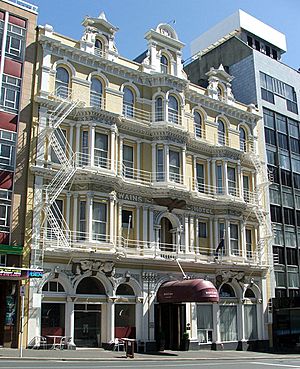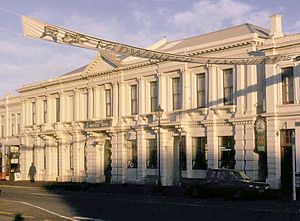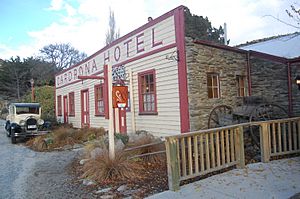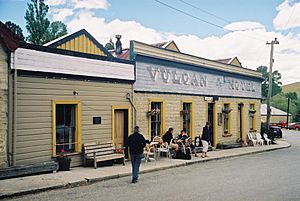List of historic hotels in Otago facts for kids
Otago, a region in New Zealand's South Island, is home to many old and interesting buildings. Lots of these buildings were once hotels or places where people could stay and eat.
Back in the late 1800s, Otago was the richest part of New Zealand. This was because of the Central Otago Gold Rush. When gold was found at Gabriel's Gully in 1861, many people came hoping to find their fortune. This made places like Queenstown, Cromwell, Clyde, Dunedin, Oamaru, and Port Chalmers grow very fast. Because of this, Otago has many grand buildings from the Victorian era.
This article lists historic hotels in Otago. These buildings are special because they are recognized by the New Zealand Historic Places Trust. They are either Category I or Category II, meaning they are very important to New Zealand's history. In New Zealand, the word "hotel" can mean a place to stay, a pub, or both.
Contents
Dunedin's Historic Hotels: A Glimpse into the Past
Dunedin, the main city in Otago, has several historic hotels. These buildings show how important the city was during the gold rush.
- Chick's Hotel, Port Chalmers (Category II): This hotel is located in the port town of Port Chalmers.
- Former Dandie Dinmont Hotel, Waverley (Category II): Built in 1880, this building was meant to be a hotel and a home. However, it was only ever used as a private house.
- Empire Hotel, Princes Street (Category I): This hotel started as The Queen's Arms in 1858. The building you see today was built in 1879. It became the Empire Hotel in 1898. Later, it was famous for its connection to the "Dunedin sound" music scene.
- Former Excelsior Hotel, Dowling Street (Category II): Another historic hotel in Dunedin's city center.
- Law Courts Hotel, Stuart Street (Category II): This is a large building with an Art Deco design in the middle of Dunedin.
- Port Chalmers Hotel, Port Chalmers (Category II): Located on Beach Street in the port town.
- Provincial Hotel, Port Chalmers (Category II): Another historic hotel found in Port Chalmers.
- Southern Cross Hotel, High Street (Category I): This hotel used to be called the Grand Hotel. It has a very fancy front and was designed in the early 1880s.
- Wains Hotel, Princes Street (Category I): This is one of Dunedin's most famous buildings. It has a very detailed outside and inside. It was built when the gold rush was at its peak.
- Former Woodhaugh Hotel, Woodhaugh (Category II): Located in the Woodhaugh area of Dunedin.
North and East Otago's Early Hotels
The towns in North and East Otago also have important historic hotels. Many of these were built from local Oamaru Stone.
- Criterion Hotel, Oamaru (Category I): Built in 1881 from Oamaru Stone, this hotel is a key part of Oamaru's historic area.
- Junction Hotel, Oamaru (Category II): This hotel is a well-known building on a hilltop near the southern entrance to Oamaru.
- Former Northern Hotel, Oamaru (Category II): This was Oamaru's very first hotel, built in 1860.
- Former Queen's Hotel, Oamaru (Category II): A large Victorian building constructed in the 1880s when Otago was very wealthy.
- Former Star and Garter Hotel, Oamaru (Category I): This hotel was built in the mid-1860s.
South and West Otago's Historic Stays
These areas also have a few historic hotels that played a role in their local communities.
- Former Waiwera Hotel, Waiwera South (Category II): This hotel is located in the small settlement of Waiwera South.
Central Otago's Gold Rush Hotels
Central Otago was the heart of the gold rush, and many hotels here served the miners and travelers.
- Ancient Briton Hotel, Naseby (Category II): Built in 1900, this hotel stands where an older goldfields pub from 1863 once stood.
- Cardrona Hotel False Front, Cardrona (Category II): The original hotel was a simple shed. To make it look grander, a tall, impressive "false front" was added. This front still exists today, even though the building behind it has been replaced.
- Former Commercial Hotel, Clyde (Category II): Now known as the Dunstan Hotel, this stone building dates back to 1903.
- Former Dunstan Hotel, Clyde (Category II): This stone building from 1900 replaced the first Dunstan Hotel, which was built during the 1860s gold rush.
- Eichardt's Hotel, Queenstown (Category II): This is one of Central Otago's most famous buildings. It was built in the 1860s and was first owned by William Gilbert Rees, who founded Queenstown.
- Former Lee Stream Hotel, Lee Stream (Category II): This hotel was an important stop for gold prospectors traveling to the goldfields around the Maniototo. It's on the main road between Outram and Middlemarch.
- Royal Hotel, Naseby (Category II): Like the Cardrona Hotel, Naseby's Royal Hotel also has a false front. This hotel, the second of its name, was built in 1865. Cobb and Co. coach services used it as a stop from 1869.
- Former Simmond's Boarding House, Alexandra (Category II): This is a notable stone building from 1882, located near the southern end of Alexandra.
- Stanley's Hotel, Macraes Flat (Category I): This stone hotel was built in 1882 and has been open for over 130 years. It has been kept in its original condition, along with its billiards room, stone shed, and stables.
- Vulcan Hotel, Saint Bathans (Category I): This iconic hotel, made of adobe brick, is a great example of a gold-miner's pub from the 1880s. It's also known as one of New Zealand's most haunted places.
- Former White Horse Hotel, Becks (Category II): Another historic hotel in the Central Otago region.
- Hulbert House, Queenstown (Category II): A historic building in Queenstown.






